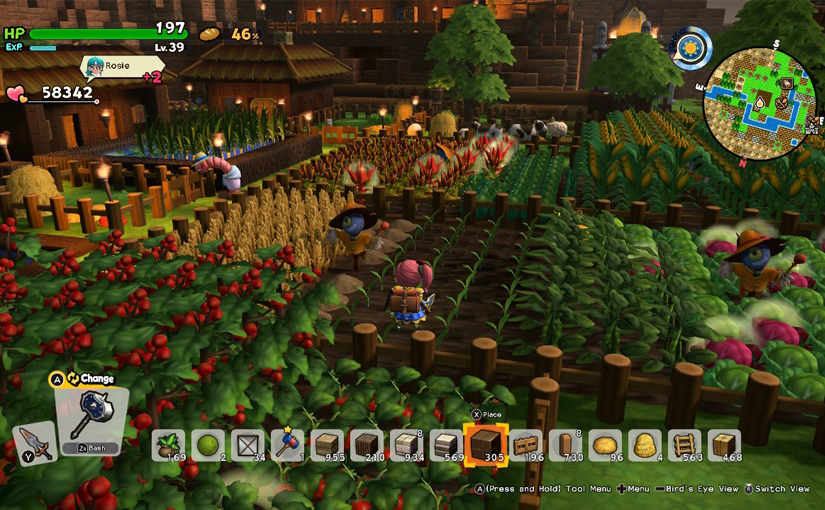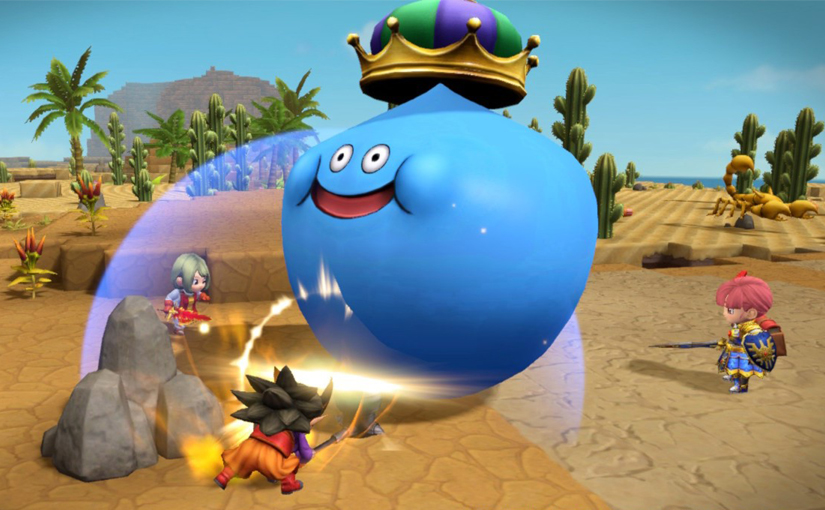Dragons, Quests, and Builders, Too!
You’d be forgiven for taking one look at the blocky visuals of Dragon Quest Builders and rolling your eyes at the thought of a Square Enix helmed cash-in on Minecraft’s success. However, while clearly taking cues from the cuboid phenomenon, this is much more than just an Akira Toriyama-themed skin pack. Personally, I came into Dragon Quest Builders 2 with relatively little experience in the Dragon Quest series. I nearly finished Dragon Quest IX: Sentinels of the Starry Skies, and finished Dragon Quest XI: Echoes of an Elusive Age, and haven’t played any other games in the series’ extensive back catalogue. Despite their wordy titles, though, I enjoyed both games immensely. As for Minecraft, my experience there is almost non-existent. I’ve tried it once or twice, but always found myself unable to get motivated to build for the sake of building in the open-ended, low-res world. I found myself getting much more involved with the 2D building of Terraria, thanks to its progression, bosses and neat graphical style.
Dragon Quest Builders 2 obviously borrows visually and stylistically from Minecraft, but does even more than Terraria did when it comes to adding focus to the sandbox. It features a lengthy quest that sets it apart from more open-ended survival/builders and a story line that, while fairly basic thanks to a silent protagonist, throws up its fair share of twists and turns. The ongoing relationship between the player-created character and his or her amnesiac companion Malroth is often interesting and occasionally moving, and the vibe can shift from upbeat and irreverent to surprisingly foreboding or hauntingly melancholy at a moments’ notice. Observant, old-school Dragon Quest fans may also recognise the name Malroth from Dragon Quest II, and will already have an inkling that there’s a lot more going on behind the scenes than meets the eye. The story chugs along nicely and, despite some slow sections, concludes in satisfying fashion, too.
The quest is split into numerous distinct parts, set on different islands in a vast, unknown sea. While undertaking the story missions on these islands, you won’t be able to leave them. Upon completing that part of the quest, however, you’re free to go back and forth between your home base (known as the Isle of Awakening) and almost any island you’ve already completed. Once you go to a new area and get stuck into the next story mission, you’re locked in again. The split nature of the world allows you to keep different projects handily separated, but can result in frustration later on when you find yourself spending far too much time propositioning the quirky Captain Brownbeard to take you from island to island, and experiencing the loading screens that are part of the deal.
There are also island types known as “Explorers’ Shores”. These randomly generated holms, cays and skerries offer up enjoyable orienteering activities in which players can unlock infinite reserves of certain resource types. You can also find optional boss fights, pick up various villagers and helpful NPCs to take back to the Isle of Awakening, and gather handy resources that you won’t find anywhere else. Don’t bother building anything, though, as the place will be swallowed by the ocean mists when you leave, never to be seen again.

Each main island will teach you different aspects of the building, survival and management elements of the game. The first island introduces you to farming and meeting your villagers’ basic needs, the second area demonstrates mining and entertainment, and so on. Complete the main quest and you’ll be armed with the knowledge to build the fantasy metropolis of your dreams back at the Isle of Awakening once the post-game opens up.
Nearly. The game keeps a lot from you, and completionists looking for all the items, cooking recipes and room types on offer will have a gigantes-sized task on their hands. The story quests will only tell you so much, the rest needs to be uncovered by following NPC hints or through a bit of good old trial and error. This is welcome, as it gives the game a wealth of content for enthusiastic builders to uncover long after the end credits have rolled. However, the game’s obliqueness can occasionally go too far, and frustrating occurrences are a little too common. Room-types not registering with no clear indication as to why, villagers ignoring your newly built facilities with no visible explanation, and a lack of clarity when determining how far out into the map you can expand your settlement are all examples of problems I encountered. All of these are understandable limits, but it would have been nice if the game attempted to explain them a bit.
Combat is basic. Swing your sword until the enemy dies, occasionally pausing to dodge obviously telegraphed power attacks. Level up and craft better swords to hit harder. That’s pretty much it. Combat isn’t the focus here, despite there being plenty of it, but variety is injected through the use of companions. Throughout most of the game you’ll be accompanied by Malroth, and you can rely on him in a lot of the battles. There will also be occasions when your party grows to four or more, and later on whole armies can be thrown into battle at your behest, though I never used this feature outside of the story mission that introduced it. While visiting the aforementioned Explorers’ Shores, you can choose up to three companions to take with you, and this adventuring party can eventually include tamed monsters. These monsters add another wrinkle to the resource-gathering, combat and exploration aspects of the game, as many of them can be ridden and used in various helpful roles.
I’ve not played the first Dragon Quest Builders game, but from a little bit of research it seems that the sequel added such a wealth of gameplay tweaks and quality of life changes that I’ll probably leave it unexplored. Having said that, I did read somewhere that Dragon Quest Builders has a double jump. Dragon Quest Builders 2 could really do with a double jump…
We can forgive it, though, because Dragon Quest Builders 2 is a thoroughly charming, content-rich and surprisingly deep game. Bright, fascinating and bizarrely pun-obsessed, the building gameplay mixes perfectly with the questing, and for the most part the balance between hand-holding and letting you do your own thing is weighed perfectly. Despite enjoying previous Dragon Quest titles, I partially dismissed Dragon Quest Builders 2 as a cash-in on the popularity of Minecraft that was squarely aimed at kids. An opportunity came to play it (it was a gift for my daughter) and I was quickly enlightened to the fact that, while both of those things are true, this is still an excellent game that will keep you coming back again and again. I want more of it, despite it having a 50+ hour campaign and near endless post-game content, and that’s a sign that something is definitely working. As far as Dragon Quest spin-offs go, this one’s built for success.
Played on Nintendo Switch

